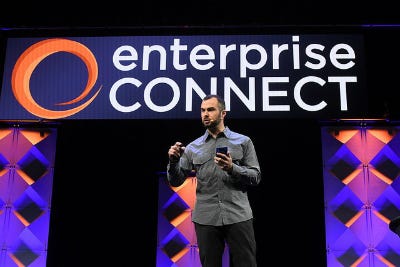Amazon showcases the next wave of voice automation powered by its recently launched Alexa for Business virtual assistant, integrated with Crestron, Cisco and Polycom conferencing hardware and conferencing services from BlueJeans, RingCentral, Microsoft and Zoom.
March 16, 2018

ENTERPRISE CONNECT — When Amazon Web Services (AWS) launched Alexa for Business late last year, the company signaled a sweeping ambition to extend its voice-controlled virtual assistant beyond its home-automation roots into the workplace.
AWS this week showed progress where it sees low-hanging fruit for partners to bring Alexa into the office: voice-activated control of audio and video conferencing systems and services.
Riding on Alexa’s success in letting consumers control their lights, thermostats and security cameras, Amazon believes its voice-controlled virtual agent is ripe for bringing automation into offices, retail environments and manufacturing plants — allowing workers to use voice commands to initiate and manage conferences via integration with audio and video conferencing systems.
Setting up conference calls and video or screen sharing conferences and running them is more complex than it needs to be, said Collin Davis, general manager of Alexa for Business at Amazon, speaking Tuesday in the opening keynote session at the Enterprise Connect conference in Orlando.
The idea to bring Alexa to business came quite innocuously last year when a group of colleagues were struggling to dial into a conference, Davis lamented.
“Someone had joked in the room, ‘Alexa, start the meeting.’ And we looked at each other and laughed, but then we realized that’s a really good idea and we go build it. So, we did.”

Collin Davis (courtesy Enterprise Connect)
Collin Davis (courtesy Enterprise Connect)
Early implementations will come from basic conference-call setup, but Amazon officials believe Alexa for Business is well suited for going deeper into the stack, such as managing usage and providing transcriptions of meetings.
The company entered the conferencing market a year ago with the debut of Chime, a service similar to Cisco WebEx, Google Hangouts, Microsoft Skype and a slew of others. In November, Amazon launched Alexa for Business and partnered with key conferencing-room system providers Crestron and Polycom and conferencing providers BlueJeans, Microsoft, RingCentral and Zoom.
Chime’s New Usage-Based Pricing
In addition to demonstrating the Alexa Voice Services integration into those systems this week, AWS took a swipe at the existing web video conferencing market with plans to offer the Chime conferencing service on an ad-hoc basis starting at $3 per user for a one-time conference, and a maximum of $15 per month. The new cut-rate plan takes effect April 1 and brings the AWS cloud service usage-based pricing model to Chime.
“It really makes sense; it’s the AWS way,” Davis said. “We like to charge customers for what they use — nothing more and without any upfront commitments.”
Amazon Chime is available as a standalone offering, but communications service providers CenturyLink (the former Level 3) and Vonage also provide it as their respective conferencing solutions. Beyond those partnerships, analysts say Chime is far from dominant. Forrester Research analyst and communications industry veteran Art Schoeller said the Chime portfolio hasn’t yet shown up in numerous inquiries.
“They’re emphasizing very heavily with me how customizable it is, especially for [unified communications], but I don’t know how much customization I want to do to make it work,” Schoeller said. “But they’re Amazon. They’re going to want to disrupt things.”
While Alexa for Business will work with Chime, Davis said the focus is on letting people initiate conferences and activate functions with voice commands with the broader ecosystem of services, hardware and applications.
“We started this process because of what we learned in the meeting room and what we observed with meeting rooms being too hard to use,” he said.
To solve that problem, AWS built its Smart Conferencing APIs, which Davis explained works much like Amazon’s Smart Home APIs. When embedded in lighting fixtures, the Smart Home APIs let people turn lights on and off using voice commands. Similarly, video-conferencing room system vendors Crestron and Polycom have embedded the Smart Conferencing API into their systems and AWS built its own implementation of it onto Cisco’s API. The Polycom Trio was on display with the interface at the conference.
The embedded API lets a meeting attendee look up a meeting dial-in information in his or her Google G Suite or Microsoft Outlook/Exchange schedule and say: “Start meeting,” which invokes the Alexa Voice Services on the system via the API calls, Davis explained.
“It represents a way for customers to get Alexa in their conference room without having to add additional hardware to their existing systems,” Davis said. In rooms without more sophisticated systems, often called huddle rooms, he added, the Echo can act as a speakerphone.
Partner Opportunities
Davis said adding voice control and intelligent automation to the meetin-room experience is an emerging opportunity for the partner community.
“Consulting partners and technology partners play a big part in our customers’ management and deployment of conference room and telephony equipment,” he said. Technology partners have opportunities to help customers build private skills, consulting partners with deploying, managing and installing this equipment. And we think that there are lots of opportunities.”
Integrators, software developers and ISVs can also tap from the Alexa Skills Kit (ASK), which now includes 30,000 tools, code samples and documentation of specific skills that programmers can build into their Alexa implementations. The company said the ASK now has 30,000 skills, mostly derived from the company’s smart-home efforts. AWS late last month also posted specific Alexa for Business skills templates in a new GIthub repository. Davis also said developers can share code and templates via the AWS Serverless Application Repository for its Lambda service.
Voice control and the application of machine learning to automate conferencing and other business processes is still largely new. While Amazon has gained an early lead in the home-automation market, Apple, IBM, Google and Microsoft are investing heavily in their respective ecosystems as well. Polycom has long supported Microsoft’s Skype for Business – and Lync before it – and demonstrated its new Microsoft Teams interface in the Trio this week.
The role Alexa plays and to what extent in the future is anyone’s guess, said Chris Thorson, Polycom’s senior director of product marketing.
“The market will decide,” he said. “I think Amazon will bring [its] muscle to the game and that will be good for the industry.”
About the Author(s)
You May Also Like


